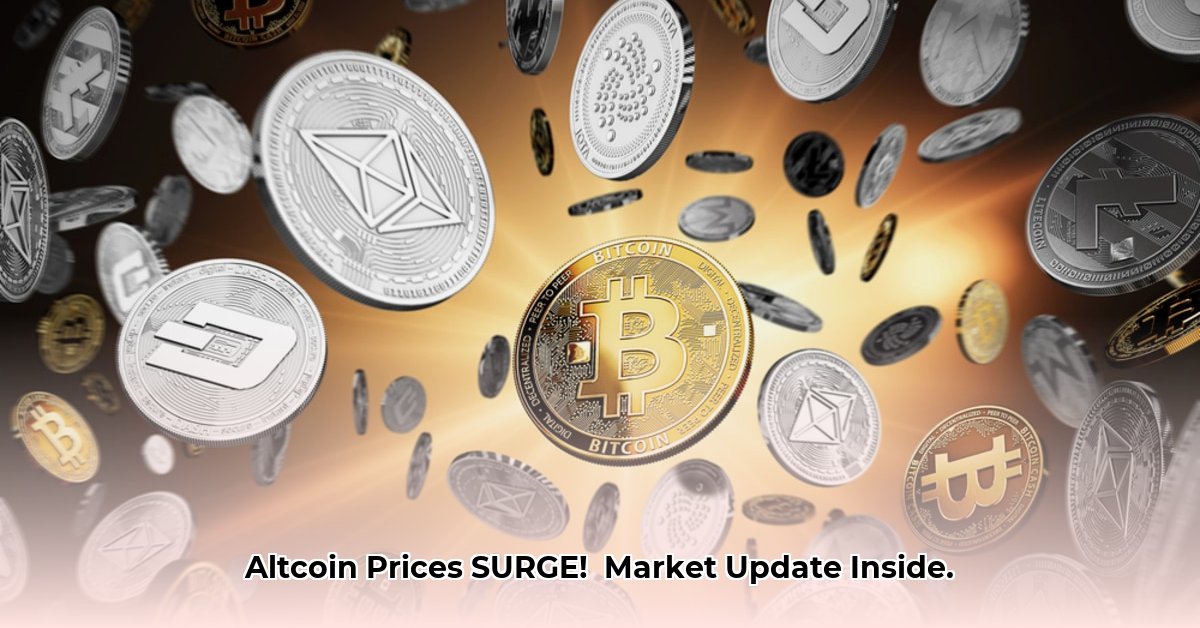What’s the latest in the ever-evolving altcoin universe? As of June 25th, the cryptocurrency market continues its fascinating dance, exhibiting both growth and underlying shifts. For real-time Bitcoin price updates, check out this live Bitcoin price. The global crypto market cap stands at $3.24 trillion, marking a 3.98% increase over the last day. Trading volume experienced a substantial surge of 10.78%. A deeper dive reveals that stablecoins dominate trading activity, accounting for a staggering 96.80% of the total crypto market 24-hour volume. Meanwhile, Bitcoin’s dominance has seen a slight decrease of 0.41%. Let’s dissect these dynamics to understand the implications for altcoins and the broader digital asset landscape.
Unpacking the Current Crypto Climate
The cryptocurrency market demonstrates continued growth, a trend not without its nuances. While the overall market has expanded, the dominance of stablecoins in trading volume suggests a risk-averse sentiment among investors. What does this mean for altcoins, those digital assets seeking to carve out their niches beyond Bitcoin’s shadow? It signals a market ripe with both opportunity and challenges, demanding shrewd navigation and informed decision-making.
Bitcoin’s Role: The Bellwether with a Caveat
Bitcoin remains a pivotal force, currently holding 64.48% of the market. However, its recent decrease of 0.41% raises questions. Is this a minor fluctuation, or does it foreshadow a more significant shift? The approval of Bitcoin ETFs has opened doors for institutional investment, yet the inherent volatility of the crypto market tempers expectations.
Altcoin Price Dynamics: A Spectrum of Performance
Today’s altcoin performance presents a mixed picture. Some altcoins are experiencing gains, fueled by specific sector developments or positive investor sentiment. Conversely, others mirror Bitcoin’s slight decline, highlighting the interconnectedness within the crypto ecosystem. These movements are rarely isolated incidents; they reflect broader market trends and investor behavior. What are the emerging narratives shaping these price changes?
Factors Driving Market Behavior
Several key factors are influencing the current crypto market dynamics:
- Stablecoin Dominance: The high percentage of stablecoin trading points to investor caution and a preference for lower-risk assets. This may indicate uncertainty about the near-term prospects of more volatile cryptocurrencies but also provides liquidity for investors to strategically deploy into altcoins.
- Technological Advancements: Innovations in smart contracts, decentralized finance (DeFi), Non-Fungible Tokens (NFTs), and play-to-earn (P2E) gaming are expanding the utility and appeal of cryptocurrencies. These developments attract new users and investment, potentially driving long-term growth.
- Regulatory Landscape: Regulatory uncertainty continues to be a major factor. While the U.S. Bitcoin ETF approval is a positive step, the absence of consistent global regulations creates challenges for both investors and businesses.
- DeFi Growth: The total volume in DeFi is currently $37.42B, 24.33% of the total crypto market 24-hour volume.
Interpreting the Data: Context is Key
Cryptocurrency market data, while valuable, should be interpreted with caution. The sheer number of cryptocurrencies and tokens makes comprehensive tracking difficult, which affects accuracy. Treat market data as a guide, not as an infallible predictor of future performance. What are the limitations of current market data collection methods?
Actionable Strategies for Different Stakeholders
Here’s a tailored breakdown of potential strategies for different participants in the crypto ecosystem:
- Individual Investors: Diversify investments across various asset classes, prioritize established, trustworthy cryptocurrencies, and implement a robust risk management strategy.
- Institutional Investors: Scrutinize the performance and impact of Bitcoin ETFs. Develop sophisticated models to predict and manage volatility, adapting to regulatory changes.
- Crypto Exchanges: Enhance security measures, optimize user experience, proactively address evolving regulations, and explore the listing of new asset classes.
- Crypto Developers: Focus on building secure, scalable, and user-friendly projects. Develop decentralized applications (dApps) with clear real-world use cases.
- Regulators: Establish transparent, equitable regulations that encourage innovation while safeguarding investors. How can regulators strike a balance between fostering growth and mitigating risks?
The Takeaway: Navigating Complexity with Prudence
The altcoin market presents a landscape of both growth and uncertainty. The sustained preference for stablecoins and the evolving regulatory environment underscores the need for a cautious approach. Diversification, diligent risk management, and continuous market monitoring are crucial for successful navigation.
Strategies for Managing Regulatory Risks in Crypto Investments
In the cryptocurrency market, managing regulatory risks is crucial for long-term financial stability. Diversifying your investments reduces the impact of any single regulatory change.
The Importance of a Diversified Portfolio
Regulatory uncertainties can significantly impact the value of cryptocurrencies. Diversification across different asset classes provides a buffer against these fluctuations.
Adapting to Regulatory Shifts
Staying informed about regulatory changes is crucial for adapting your strategies. Being proactive can help you mitigate potential risks and capitalize on new opportunities. Increased regulation offers stability but can also potentially hinder innovation. What is the relationship between regulation and innovation in the crypto sector?
Geographic Diversification
Different countries have varying regulatory frameworks for cryptocurrencies. Investing in projects under different jurisdictions can reduce exposure to regulatory crackdowns. This approach is akin to insurance against legal changes.
Understanding Technical and Fundamental Analysis
Technical analysis involves studying charts and graphs to predict price movements. Fundamental analysis assesses the intrinsic value of a cryptocurrency project. Both approaches are essential for informed decision-making and effective risk management.
Practical Risk Management Techniques
Effective risk management involves:
- Defining Risk Tolerance: Understand your capacity for potential losses before investing.
- Setting Realistic Goals: Avoid unrealistic “get-rich-quick” schemes.
- Using Stop-Loss Orders: Automatically sell your cryptocurrency if it falls below a set price.
- Regular Portfolio Reviews: Track performance, rebalance holdings, and adjust strategies as needed.
- Staying Informed: Keep abreast of market trends, regulatory changes, and technological advancements.
Long-Term Perspective
The cryptocurrency market is prone to volatility. Short-term price fluctuations are normal. Avoid making impulsive decisions based on emotions. Adhere to your risk management plan and focus on long-term growth.
Advanced Altcoin Investment Strategies for 2025 and Beyond
Looking ahead, strategic investment in altcoins requires a nuanced understanding of market trends, technological advancements, and regulatory impacts.
Post-Election Market Dynamics
The post-election regulatory landscape will significantly influence the crypto market. Clarity in regulations is expected to boost institutional investments and drive a potential bull market.
Key Altcoin Sectors to Watch
Several sectors show promise for high growth:
- Layer 2 Solutions: These improve scalability by processing transactions off the main blockchain.
- Decentralized Finance (DeFi): DeFi platforms offer innovative financial services without intermediaries.
- AI-Integrated Projects: Altcoins incorporating artificial intelligence can enhance efficiency and automation.
Evaluating Pre-Sales
Investing in pre-sales carries higher risk. Thorough research and due diligence are essential before participating in any token offering.
Regulatory Compliance
Compliance with evolving regulations is mandatory. Investments should be aligned with legal and regulatory requirements to avoid potential penalties.
Strategic Considerations
- Economic Indicators: Track economic indicators for forecasting market trends.
- Technology Adoption: Monitor the increasing adoption of blockchain technology in various industries.
- Environmental Concerns: Consider the environmental impact of different cryptocurrencies. Sustainable cryptocurrencies may become more attractive to investors.
| Altcoin Sector | Example Altcoin(s) | Price Movement (June 25th) | Notable Trends |
|---|---|---|---|
| Layer 2 Solutions | Polygon (MATIC), Arbitrum (ARB) | Varied | Increased interest in scalability solutions; potential for higher transaction throughput and lower fees. |
| Decentralized Finance (DeFi) | Uniswap (UNI), Aave (AAVE) | Fluctuating | Continued confidence in decentralized financial services; growth in lending, borrowing, and trading protocols. |
| AI-Integrated Projects | Fetch.ai (FET), SingularityNET (AGI) | Consolidating | Technical refinement; potential for automation and improved efficiency in various applications. |
| Sustainable Cryptocurrencies | Chia (XCH), Algorand (ALGO) | Increasing Interest | Growing interest in environmentally friendly cryptocurrencies; potential for attracting environmentally conscious investors. |
- Uncover Timeless Ancient Greece Female Names: A Guide to Choosing the Perfect Name - August 9, 2025
- Explore Ancient Greece Artifacts: Unveiling Iconic Treasures - August 9, 2025
- Unveiling Ancient Greek Marriage: Customs & Laws Revealed - August 9, 2025
















